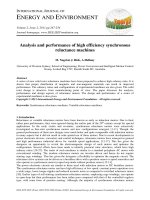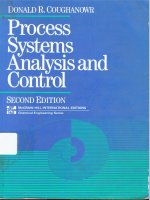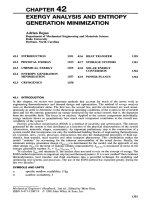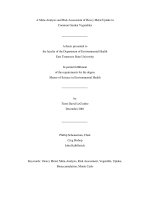Kaplan MCAT review 2015 critical analysis and reasoning skills review
Bạn đang xem bản rút gọn của tài liệu. Xem và tải ngay bản đầy đủ của tài liệu tại đây (2.88 MB, 331 trang )
MCAT® Critical Analysis and Reasoning
Skills Review
Edited by Alexander Stone Macnow, MD
Table of Contents
1. MCAT® Critical Analysis and Reasoning Skills Review
1. Cover
1. Title Page
2. Table of Contents
3. The Kaplan MCAT Review Team
4. About the MCAT
5. How This Book Was Created
6. Using This Book
2. Chapter 1: About CARS
1. About CARS
2. Introduction
3. 1.1 The CARS Section
4. 1.2 Passages
5. 1.3 Question Categories
6. Conclusion
7. Concept and Strategy Summary
3. Chapter 2: Analyzing Rhetoric
1. Analyzing Rhetoric
2. Introduction
3. 2.1 What Is Rhetoric?
4. 2.2 Key Components of Rhetoric
5. 2.3 Rhetorical Analysis
6. Conclusion
7. Concept and Strategy Summary
4. Chapter 3: Keywords
1. Keywords
2. Introduction
3. 3.1 Reading Strategically with Keywords
4. 3.2 Relation Keywords
5. 3.3 Author Keywords
6. 3.4 Logic Keywords
7. Conclusion
8. Concept and Strategy Summary
5. Chapter 4: Outlining the Passage
1. Outlining the Passage
2. Introduction
3. 4.1 The Kaplan Method for CARS Passages
4. 4.2 Reverse-Engineering the Author’s Outline
5. 4.3 Practicing the Strategy
6. Conclusion
7. Concept and Strategy Summary
6. Chapter 5: Dissecting Arguments
7.
8.
9.
10.
11.
1. Dissecting Arguments
2. Introduction
3. 5.1 Domains of Discourse
4. 5.2 Concepts: The Basic Elements of Logic
5. 5.3 Claims: The Bearers of Truth Value
6. 5.4 Arguments: Conclusions and Evidence
7. Conclusion
8. Concept and Strategy Summary
Chapter 6: Formal Logic
1. Formal Logic
2. Introduction
3. 6.1 The Logic of Conditionals
4. 6.2 Applications of Conditionals
5. 6.3 Analogical Reasoning
6. Conclusion
7. Concept and Strategy Summary
Chapter 7: Understanding Passages
1. Understanding Passages
2. Introduction
3. 7.1 Varieties of Passages
4. 7.2 Support in Passages
5. 7.3 Anticipating Questions
6. Conclusion
7. Concept and Strategy Summary
Chapter 8: Question and Answer Strategy
1. Question and Answer Strategy
2. Introduction
3. 8.1 Kaplan Method for CARS Questions
4. 8.2 Wrong Answer Pathologies
5. 8.3 Signs of a Healthy Answer
6. Conclusion
7. Concept and Strategy Summary
Chapter 9: Question Types I: Foundations of Comprehension Questions
1. Question Types I: Foundations of Comprehension Questions
2. Introduction
3. 9.1 Main Idea Questions
4. 9.2 Detail Questions
5. 9.3 Function Questions
6. 9.4 Definition-in-Context Questions
7. Conclusion
8. Concept and Strategy Summary
Chapter 10: Question Types II: Reasoning Within the Text Questions
1. Question Types II: Reasoning Within the Text Questions
2. Introduction
3. 10.1 Inference Questions
4. 10.2 Strengthen–Weaken (Within the Passage) Questions
5. 10.3 Other Reasoning Within the Text Questions
6. Conclusion
7. Concept and Strategy Summary
12. Chapter 11: Question Types III: Reasoning Beyond the Text Questions
1. Question Types III: Reasoning Beyond the Text Questions
2. Introduction
3. 11.1 Apply Questions
4. 11.2 Strengthen–Weaken (Beyond the Passage) Questions
5. 11.3 Other Reasoning Beyond the Text Questions
6. Conclusion
7. Concept and Strategy Summary
13. Chapter 12: Effective Review of CARS
1. Effective Review of CARS
2. Introduction
3. 12.1 Learning from Your Mistakes
4. 12.2 Thinking Like the Testmaker: Post-Phrasing
5. 12.3 Improving Your Timing
6. 12.4 Building Endurance
7. 12.5 Enhancing Your Vocabulary
8. Conclusion
9. Concept and Strategy Summary
14. About This Book
1. Copyright Information
2. Special Offer for Kaplan Students
The Kaplan MCAT Review Team
Alexander Stone Macnow, MD
Editor-in-Chief
M. Dominic Eggert
Kaplan MCAT Faculty
Kimberly Sinnott, MA
Kaplan MCAT Faculty
MCAT faculty reviewers Elmar R. Aliyev; James Burns; Jonathan Cornfield; Alisha Maureen
Crowley; Nikolai Dorofeev, MD; Benjamin Downer, MS; Colin Doyle; Marilyn Engle; Eleni M.
Eren; Raef Ali Fadel; Tyra Hall-Pogar, PhD; Scott Huff; Samer T. Ismail; Elizabeth A. Kudlaty;
Kelly Kyker-Snowman, MS; Ningfei Li; John P. Mahon; Matthew A. Meier; Nainika Nanda; Caroline
Nkemdilim Opene; Kaitlyn E. Prenger; Uneeb Qureshi; Derek Rusnak, MA; Kristen L. Russell, ME;
Bela G. Starkman, PhD; Michael Paul Tomani, MS; Nicholas M. White; Kerranna Williamson, MBA;
Allison Ann Wilkes, MS; and Tony Yu
Thanks to Kim Bowers; Tim Eich; Samantha Fallon; Owen Farcy; Dan Frey; Robin Garmise; Rita
Garthaffner; Joanna Graham; Adam Grey; Allison Harm; Beth Hoffberg; Aaron Lemon-Strauss; Keith
Lubeley; Diane McGarvey; Petros Minasi; John Polstein; Deeangelee Pooran-Kublall, MD, MPH;
Rochelle Rothstein, MD; Larry Rudman; Sylvia Tidwell Scheuring; Carly Schnur; Karin Tucker; Lee
Weiss; and the countless others who made this project possible.
About the MCAT
The structure of the four sections of the MCAT is shown below.
Chemical and Physical Foundations of Biological Systems
Time
Format
95 minutes
59 questions
10 passages
44 questions are passage-based, and 15 are discrete (stand-alone) questions.
Score between 118 and 132
What It Tests
Biochemistry: 25%
Biology: 5%
General Chemistry: 30%
Organic Chemistry: 15%
Physics: 25%
Critical Analysis and Reasoning Skills (CARS)
Time
Format
90 minutes
53 questions
9 passages
All questions are passage-based. There are no discrete (stand-alone) questions.
Score between 118 and 132
What It Tests
Disciplines:
Humanities: 50%
Social Sciences: 50%
Skills:
Foundations of Comprehension: 30%
Reasoning Within the Text: 30%
Reasoning Beyond the Text: 40%
Biological and Biochemical Foundations of Living Systems
Time
Format
95 minutes
59 questions
10 passages
44 questions are passage-based, and 15 are discrete (stand-alone) questions.
Score between 118 and 132
Biochemistry: 25%
What It Tests
Biology: 65%
General Chemistry: 5%
Organic Chemistry: 5%
Psychological, Social, and Biological Foundations of Behavior
Time
95 minutes
59 questions
Format
10 passages
44 questions are passage-based, and 15 are discrete (stand-alone) questions.
Score between 118 and 132
Biology: 5%
What It Tests
Psychology: 65%
Sociology: 30%
Total
Testing Time
375 minutes (6 hours, 15 minutes)
Questions
230
Score
472 to 528
The MCAT also tests four Scientific Inquiry and Reasoning Skills (SIRS):
1. Knowledge of Scientific Concepts and Principles (35% of questions)
2. Scientific Reasoning and Problem-Solving (45% of questions)
3. Reasoning About the Design and Execution of Research (10% of questions)
4. Data-Based and Statistical Reasoning (10% of questions)
The MCAT is a computer-based test (CBT) and is offered at Prometric centers during almost every
month of the year. There are optional breaks between each section, and there is a lunch break between
the second and third section of the exam.
Register online for the MCAT at www.aamc.org/mcat
.
For further questions, contact the MCAT team at the Association of American Medical Colleges:
MCAT Resource Center
Association of American Medical Colleges
(202) 828-0690
www.aamc.org/mcat
How This Book Was Created
The Kaplan MCAT Review project began in November 2012 shortly after the release of the Preview
Guide for the MCAT 2015 Exam, 2nd edition. Through thorough analysis by our staff
psychometricians, we were able to analyze the relative yield of the different topics on the MCAT, and
we began constructing tables of contents for the books of the Kaplan MCAT Review series.
Writing of the books began in April 2013. A dedicated staff of 19 writers, 7 editors, and 32
proofreaders worked over 5000 combined hours to produce these books. The format of the books was
heavily influenced by weekly meetings with Kaplan’s learning-science team.
These books were submitted for publication in July 2014. For any updates after this date, please
visit www.kaplanmcat.com .
The information presented in these books covers everything listed on the official MCAT content lists
—nothing more, nothing less. Every topic in these lists is covered in the same level of detail as is
common to the undergraduate and postbaccalaureate classes that are considered prerequisites for the
MCAT. Note that your premedical classes may cover topics not discussed in these books, or they may
go into more depth than these books do. Additional exposure to science content is never a bad thing,
but recognize that all of the content knowledge you are expected to have walking in on Test Day is
covered in these books.
If you have any questions about the content presented here, email
. For other questions not related to content, email
.
Each book has been vetted through at least six rounds of review. To that end, the information
presented is these books is true and accurate to the best of our knowledge. Still, your feedback helps
us improve our prep materials. Please notify us of any inaccuracies or errors in the books by sending
an email to .
Using This Book
Kaplan MCAT Critical Analysis and Reasoning Skills Review, along with the other six books in the
Kaplan MCAT Review series, brings the Kaplan classroom experience to you—right in your home, at
your convenience. This book offers the same Kaplan content review, strategies, and practice that
make Kaplan the #1 choice for MCAT prep. After all, twice as many doctors prepared with Kaplan
for the MCAT than with any other course.
This book is designed to help you review the Critical Analysis and Reasoning Skills section of the
MCAT. It represents one of the content review resources available to you. Additional review is
available in your Online Center, including more practice questions and full-length practice exams.
Register for your Online Center at kaptest.com/booksonline .
Unlike the other books in this MCAT series, there is no content to review for the Critical Analysis
and Reasoning Skills section. The questions are written in such a way that they do not presume any
prior fund of knowledge. In other words, all the support that is needed to answer the questions
correctly is found in the corresponding passages.
SIDEBARS
The following is a guide to the five types of sidebars you’ll find in Kaplan MCAT Critical Analysis
and Reasoning Skills Review:
Bridge: These sidebars create connections between science topics that appear in multiple
chapters throughout the Kaplan MCAT Review series.
Key Concept: These sidebars draw attention to the most important takeaways in a given topic,
and they sometimes offer synopses or overviews of complex information. If you understand
nothing else, make sure you grasp the Key Concepts for any given subject.
MCAT Expertise: These sidebars point out how information may be tested on the MCAT or
offer key strategy points and test-taking tips that you should apply on Test Day.
Real World: These sidebars illustrate how a concept in the text relates to the practice of
medicine or the world at large. While this is not information you need to know for Test Day,
many of the topics in Real World sidebars are excellent examples of how a concept may appear
in a passage or question on the MCAT.
In this end, this is your book, so write in the margins, draw diagrams, highlight the key points—do
whatever is necessary to help you get that higher score. We look forward to working with you as you
achieve your dreams and become the doctor you deserve to be!
In This Chapter
1.1
1.2
1.3
The CARS Section
Passages
Question Categories
Foundations of Comprehension
Reasoning Within the Text
Reasoning Beyond the Text
Concept and Strategy Summary
Introduction
Congratulations! You are about to embark upon an exciting journey down the path to medical school
to achieve your goal of becoming a doctor. Like any major journey in life, this will require thorough
preparation. Fortunately, you don’t have to prepare for this journey on your own: Kaplan offers
comprehensive preparation for the MCAT with proven strategies that can enhance your score in all
sections of the exam.
As a premedical student, you have already been exposed to a wide variety of science topics, which
will be tested in the three science sections of the test. In contrast, the Critical Analysis and
Reasoning Skills (CARS) section will present you with an array of passages from various disciplines
to which you may have never been exposed—for example, a musicological analysis of Johannes
Brahms’s 1868 masterpiece Ein Deutsches Requiem, a philosophical diatribe criticizing Immanuel
Kant’s Metaphysics, or a dissection of the political underpinnings of the development of the
Medicare system—and you will be expected to read, understand, and apply this knowledge. Students
often find themselves overwhelmed or feel ill-equipped for the CARS section of the test, but Kaplan
is here to help! This book will help you understand what is expected of you in CARS and presents the
Kaplan strategies that have paved the way for many thousands of students to become the doctors they
deserve to be.
In this chapter, we will go over the structure of the CARS section of the MCAT, as well as the
diverse disciplines encountered in CARS passages. We’ll provide a brief overview of the question
categories identified by the Association of American Medical Colleges (AAMC). Finally, we’ll
discuss how to use this book and how it can guide you in preparing for your MCAT and the journey
beyond. The journey to becoming a physician may be long, but it is ultimately extremely rewarding.
Some day in the future, you’ll find yourself donning your white coat, changing patients’ lives, and
realizing that having the right plan for success is what made the journey possible.
1.1 The CARS Section
In some ways, the Critical Analysis and Reasoning Skills (CARS) section of the MCAT will be
nothing new to you; it is similar to many of the standardized tests you have taken throughout your
academic career, presenting you with passages to read and multiple choice questions to gauge your
understanding. In 90 minutes, you will be presented with passages, each of which will be followed by
approximately 5 to 7 questions, for a total of 53 questions. The passages you encounter will be
relatively short (but lengthier than the science passages on the test), ranging from 500 to 600 words.
Unlike reading comprehension sections you have come across previously, such as those in the SAT®
or ACT®, the CARS section of the MCAT has been designed to assess analytical and reasoning skills
that are required in medical school. The passages you will face in CARS will be multifaceted,
incorporating advanced vocabulary, presenting varied writing styles, and requiring higher-level
thought. To answer the accompanying questions, you will have to go beyond merely comprehending
the content of a CARS passage: you will need to analyze its rhetorical and logical structure, and even
be able to assess how it impacts (or is impacted by) outside information.
1.2 Passages
The types of passages chosen for CARS consist of multiple paragraphs that require active, critical
reading to answer the questions that follow. The passages included on the section are from an array of
disciplines in the social sciences and humanities, as listed in Table 1.1. Approximately half of the
passages (and questions) that you encounter on Test Day will fall in the realm of the humanities,
while the other half will be in the social sciences. All of the passages that appear in CARS are
selected from books, journals, and other publications similar to those you have come across in
academic settings.
Humanities
Social Sciences
Architecture
Anthropology
Art
Archaeology
Dance
Economics
Ethics
Education
Literature
Geography
Music
History
Philosophy
Linguistics
Popular Culture
Political Science
Religion
Population Health
Studies of Diverse Cultures*
Psychology
Theater
Sociology
Studies of Diverse Cultures*
* Note: Studies of Diverse Cultures can be tested in both humanities and social sciences passages.
1. From The Official Guide to the MCAT 2015 Exam, 4th Edition.
Table 1.1. Humanities and Social Sciences Disciplines in the CARS Section1
For students who have exclusively focused on the sciences, information for the fields used in the
CARS section may be presented in a strikingly different way that can sometimes seem overwhelming.
This book will review the writing styles used for the passages in CARS and explain how to read
these passages with purpose, which will ultimately make them much less intimidating and
significantly more manageable.
1.3 Question Categories
The AAMC has identified three categories of questions in CARS that will assess your critical
thinking skills: Foundations of Comprehension, Reasoning Within the Text, and Reasoning Beyond
the Text questions.
FOUNDATIONS OF COMPREHENSION
These questions tend to be straightforward. They will ask about the main ideas of a passage, specific
details from within the passage, the purpose of a given part of the passage, or the likely meaning of a
word or phrase based on context. These questions are the most similar to those you have seen in
previous standardized tests because they only ask for reading comprehension (understanding what you
have read). Questions in Foundations of Comprehension will make up 30 percent of the questions in
CARS.
In Chapter 9 of MCAT CARS Review, we will further dissect the four question types within
Foundations of Comprehension:
Main Idea
Detail
Function
Definition-in-Context
REASONING WITHIN THE TEXT
Reasoning Within the Text questions require greater thought than Foundations of Comprehension
questions because they will ask you to draw inferences (unstated parts of arguments that logically
must be true based on the information given) or ask how one piece of information relates to another
(as a piece of evidence that supports a conclusion, for example). Questions in Reasoning Within the
Text will make up 30 percent of the questions in CARS.
In Chapter 10 of MCAT CARS Review, we will further dissect the two main question types within
Reasoning Within the Text and a few other, rare questions that fit into this category:
Inference
Strengthen–Weaken (Within the Passage)
REASONING BEYOND THE TEXT
Reasoning Beyond the Text questions focus on two specific skills: first, the capacity to extrapolate
information from the passage and place it within new contexts and, second, the ability to ascertain
how new information would relate to and affect the concepts in the passage. Questions in Reasoning
Beyond the Text will make up 40 percent of the questions in CARS.
In Chapter 11 of MCAT CARS Review, we will further dissect the two main question types within
Reasoning Beyond the Text and a few other, rare questions that fit into this category:
Apply
Strengthen–Weaken (Beyond the Passage)
Conclusion
This chapter is only a beginning. Now that we have covered the structure of the CARS section, we
will dive into the Kaplan strategies that will help you score points on Test Day. In Chapter 2, we will
begin with an analysis of rhetoric, exploring how a passage’s author creates a conduit for the
transmission of a message to an audience.
In Chapter 3, we will discuss critical reading and, specifically, how keywords will underlie your
ability to master all four modes of reading. We continue that conversation in Chapter 4 through the
Kaplan Method for CARS Passages. Chapters 5 and 6 similarly constitute a single unit; in Chapter 5,
we look at how arguments are constructed, and in Chapter 6, we bring in introductory formal logic to
create a systematized approach to these arguments. Chapter 7 serves as a turning point as we segue
from discussing the varieties of passages and common passage structures to anticipating questions. In
Chapter 8, we introduce the Kaplan Method for CARS Questions, and then we see its application, in
the three following chapters, in each of the different AAMC categories. Finally, we end with a look at
how to review your practice tests to find your personal test-taking pathologies and keep improving
that score.









